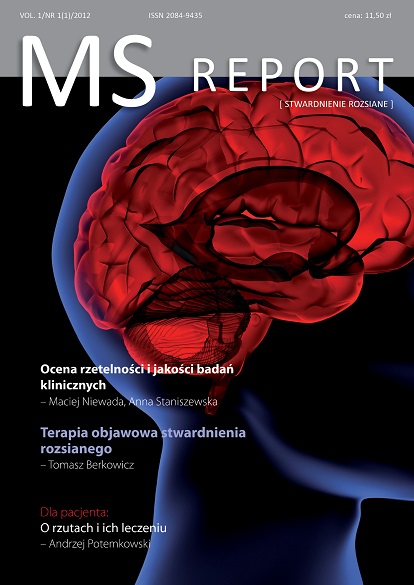Ocena rzetelności i jakości badań klinicznych Artykuł przeglądowy
##plugins.themes.bootstrap3.article.main##
Abstrakt
Ocena jakości i wiarygodności badań klinicznych ma podstawowe znaczenie w wyznaczaniu standardów postępowania diagnostyczno-terapeutycznego. W artykule przedstawiono wybrane, najważniejsze elementy organizacji i interpretacji wyników badań klinicznych. W kontekście zdefiniowanych błędów systematycznych omówiono między innymi rolę randomizacji, utajnienia kodu randomizacji oraz informacji o przydziale chorych do poszczególnych grup, metodę zaślepienia, gradację punktów końcowych oceny skuteczności, wybrane statystyczne aspekty analizy i interpretacji wyników badań klinicznych. Dla pełnego zobrazowania złożoności oceny rzetelności badań klinicznych omówiono specyficzne skale wykorzystywane do tego celu, osobno dla badań eksperymentalnych i obserwacyjnych.
##plugins.themes.bootstrap3.article.details##
Copyright © by Medical Education. All rights reserved.
Bibliografia
2. Zhehui L., Gardiner J.C., Bradley C.J.: Applying propensity score methods in medical research: pitfalls and prospects. Med. Care Res. Rev. 2010; 67: 528-54.
3. Pirracchio R., Sprung C., Payen D., Chevret S.: Benefits of ICU admission in critically ill patients: Whether instrumental variable methods or propensity scores should be used. BMC Medical Research Methodology 2011; 11: 132.
4. Lalani T., Cabell C.H., Benjamin D.K. et al.: Analysis of the impact of early surgery on in-hospital mortality of native valve endocarditis: use of propensity score and instrumental variable methods to adjust for treatment-selection bias. Circulation 2010; 121: 1005-13.
5. Earle C.C., Tsai J.S., Gelber R.D., Weinstein M.C., Neumann P.J., Weeks J.C.: Effectiveness of chemotherapy for advanced lung cancer in the elderly: instrumental variable and propensity analysis. J. Clin. Oncol. 2001; 19: 1064-70.
6. Schulz K.F., Grimes D.A.: Generation of allocation sequences in randomised trials: chance, not choice. Lancet 2002; 359: 515-9.
7. Wood L., Egger M., Gluud L.L. et al.: Empirical evidence of bias in treatment effect estimates in controlled trials with different interventions and outcomes: meta-epidemiological study. BMJ 2008; 336: 601-5.
8. Huitfeldt B., Hummel J.: The draft FDA guideline on non-inferiority clinical trials: a critical review from European pharmaceutical industry statisticians. Pharm. Stat. 2011; 10: 414-9.
9. Diener H.C., Connolly S.J., Ezekowitz M.D. et al.: Dabigatran compared with warfarin in patients with atrial fibrillation and previous transient ischaemic attack or stroke: a subgroup analysis of the RELY trial. Lancet Neurology 2010; 9: 1157-63.
10. Agencja Oceny Technologii Medycznych. Wytyczne oceny technologii medycznych (HTA). Warszawa 2009.
11. Bryant D., Schunemann H., Brozek J., Jaeschke R., Guyatt G.: Ogólne podstawy i zasady interpretacji punktów końcowych ocenianych przez pacjenta. Polskie Archiwum Medycyny Wewnętrznej 2007; 117(4): 5-11.
12. Fergusson D.A., Hebert P.C., Mazer C.D. et al.: A comparison of aprotinin and lysine analogues in high-risk cardiac surgery. The New England Journal of Medicine 2008; 358: 2319-31.
13. Major cardiovascular events in hypertensive patients randomized to doxazosin vs chlorthalidone: the antihypertensive and lipid-lowering treatment to prevent heart attack trial (ALLHAT). ALLHAT Collaborative Research Group. JAMA: The Journal of the American Medical Association 2000; 283: 1967-75.
14. Echt D.S., Liebson P.R., Mitchell L.B. et al.: Mortality and morbidity in patients receiving encainide, flecainide, or placebo. The Cardiac Arrhythmia Suppression Trial. The New England Journal of Medicine 1991; 324: 781-8.
15. Califf R.M., Adams K.F., McKenna W.J. et al.: A randomized controlled trial of epoprostenol therapy for severe congestive heart failure: The Flolan International Randomized Survival Trial (FIRST). American Heart Journal 1997; 134: 44-54.
16. Phrommintikul A., Haas S.J., Elsik M., Krum H.: Mortality and target haemoglobin concentrations in anaemic patients with chronic kidney disease treated with erythropoietin: a meta-analysis. Lancet 2007; 369: 381-8.
17. Rossouw J.E., Anderson G.L., Prentice R.L. et al.: Risks and benefits of estrogen plus progestin in healthy postmenopausal women: principal results From the Women’s Health Initiative randomized controlled trial. JAMA: The Journal of the American Medical Association 2002; 288: 321-33.
18. Haguenauer D., Welch V., Shea B., Tugwell P., Adachi J.D., Wells G.: Fluoride for the treatment of postmenopausal osteoporotic fractures: a meta-analysis. Osteoporos. Int. 2000; 11: 727-38.
19. Hampton J.R., van Veldhuisen D.J., Kleber F.X. et al.: Randomised study of effect of ibopamine on survival in patients with advanced severe heart failure. Second Prospective Randomised Study of Ibopamine on Mortality and Efficacy (PRIME II) Investigators. Lancet 1997; 349: 971-7.
20. Oliver M.F.: Cholesterol, coronaries, clofibrate and death. The New England Journal of Medicine 1978; 299: 1360-2.
21. Devereaux P.J., Yang H., Yusuf S. et al.: Effects of extended-release metoprolol succinate in patients undergoing non-cardiac surgery (POISE trial): a randomised controlled trial. Lancet 2008; 371: 1839-47.
22. Packer M., Carver J.R., Rodeheffer R.J. et al.: Effect of oral milrinone on mortality in severe chronic heart failure. The PROMISE Study Research Group. The New England Journal of Medicine 1991; 325: 1468-75.
23. Sackner-Bernstein J.D., Kowalski M., Fox M., Aaronson K.: Short-term risk of death after treatment with nesiritide for decompensated heart failure: a pooled analysis of randomized controlled trials. JAMA: The Journal of the American Medical Association 2005; 293: 1900-5.
24. Nissen S.E., Wolski K.: Effect of rosiglitazone on the risk of myocardial infarction and death from cardiovascular causes. The New England Journal of Medicine 2007; 356: 2457-71.
25. Meinert C.L., Knatterud G.L., Prout T.E., Klimt C.R.: A study of the effects of hypoglycemic agents on vascular complications in patients with adult-onset diabetes. II. Mortality results. Diabetes 1970; 19(Suppl.): 789-830.
26. Barter P.J., Caulfield M., Eriksson M. et al.: Effects of torcetrapib in patients at high risk for coronary events. The New England Journal of Medicine 2007; 357: 2109-22.
27. Jadad A.R., Moore R.A., Carroll D. et al.: Assessing the quality of reports of randomized clinical trials: is blinding necessary? Controlled Clinical Trials 1996; 17: 1-12.

